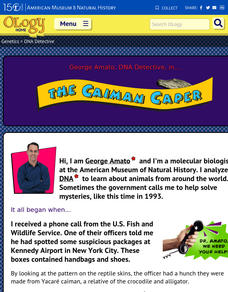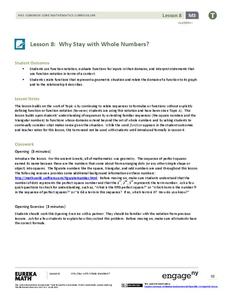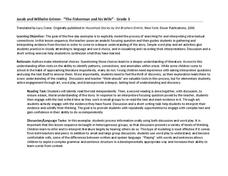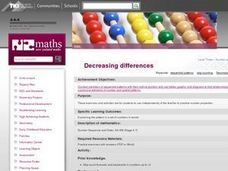Curated OER
Synthetic Division Review
In this synthetic division worksheet, learners use synthetic division to divide a binomial. Explanations and examples are provided. This three-page worksheet contains ten problems, with answers.
Science-Class.net
Rock Candy Crystals
Candy is one of my favorite words, and it's an even better word when it relates to science. Yes, candy science can happen when you grow rock candy crystals with your class. The entire process for growing these edible wonders of nature is...
Shmoop
ELA.CCSS.ELA-Literacy.RI.11-12.3
Make analyzing the sequence of events in an informational text easy. Ask readers to craft a one-sentence summary of each paragraph in a document and create a text map. To demonstrate their understanding of the process, participants read...
Curated OER
Fibonacci Numbers
Students calculate the Fibonacci sequence of numbers. Through the use of Fibonacci numbers in flowers, leaves, fruits, vegetables, pine cones, and other forms of nature; students explore how Fibonacci numbers occur in nature. Then they...
Curated OER
A Hodgepodge of Literature
Students complete multiple lessons to study various literature including poetry, fiction, tall tales, and phrases. In this literature lesson, students complete six lessons about poetry, fiction, and idioms.
Curated OER
More Congruent Triangles
In this congruent triangles learning exercise, 10th graders solve 6 various forms of problems that include a proof and a word problem. First, they draw and label triangles and indicate the additional pairs of corresponding parts that...
Curated OER
Shell Sort; Serving up Seafood
Students complete various small group activities to classify items and determine the types of combinations that can be made with these items. In the second lesson, students create menus for a restaurant to help them gain money sense and...
Curated OER
Picture This!
First graders watch the teacher model how to draw pictures and write words in a First, Next, Then, Last - 4 block graphic organizer. They write and draw in their own 4 block papers.
Curated OER
Paragraph Writing
Third graders write paragraphs. For this paragraph lesson, 3rd graders discover the parts of a paragraph as they are compared to the pieces of a sandwich. They write their own paragraph to a foreign pen-pal describing our country.
Curated OER
Guided Reading -- If You Give a Mouse a Cookie
Students are read the book "If You Give a Mouse a Cookie" page by page and discuss their favorite types of cookies. They predict what they believe will happen next based on what has already happened in the story. They practice putting...
Curated OER
Finding Fibonacci
Students study and apply the Fibonacci numbers and how they occur in nature. Students solve problems using the Fibonacci numbers.
Curated OER
Worksheet 4.12, Induction
In this math worksheet, students prove given propositions for all integer values of the variable. Students use induction to prove statements true.
Curated OER
Worksheet: Ordering Decimals and Fractions
In this ordering decimals and fractions worksheet, students rewrite fractions in the same unit and then place them in sequential order. A "how to" example is given, with step by step instructions. Eight problems are provided. Students...
Curated OER
Building Shapes From Numbers
Students experience how to illustrate some of the many connections between number and geometry. Through this 2-3 day focus on square numbers and triangular numbers, students make connections among mathematical topics.
Curated OER
Patterns Across Cultures: The Fibonacci Sequence in Visual Art
Students study the origin of the Fibonacci Sequence. In this investigative instructional activity students identify works of art where Golden Spiral or Ratio appear.
Curated OER
Rivers that Flow from the Continental Divide: The Journey of Two Rivers
Students explore river routes. In this social studies lesson, students trace the route of a river from its source and discuss the Continental Divide. Students draw the route the river takes and name the states it flows through. Students...
American Museum of Natural History
DNA Detective
Match up the DNA code. Pupils read the website from the American Museum of Natural History about how DNA can determine whether a skin is from a particular type of reptile. Using the same technique, learners match up products with the...
EngageNY
Why Stay with Whole Numbers?
Domain can be a tricky topic, especially when you relate it to context, but here is a lesson that provides concrete examples of discrete situations and those that are continuous. It also addresses where the input values should begin and...
Hood River County School District
Text Structure: Features and Organization
Teach learners how to interact with both fiction and non-fiction text with a packet of activities and worksheets. After looking over text structure and the difference in text features between different types of writing, readers analyze...
Curated OER
Molecular Biology and Primate Phylogenics
By counting differences in amino acids, biology stars examine the relationships between different primates. With information gleaned, they map out a phylogenic tree and discover common ancestry. You will need to create printable versions...
Curated OER
The Fisherman and His Wife
Engage conversation and explore the journey as you challenge young readers to interpret the german folktale, "The Fisherman and His Wife" written by literary brothers Jacob and Wilhelm Grimm.
Curated OER
Decreasing Differences
Students identify and interpret the pattern within a set of numbers using words. Then they write rules in words using complete sentences. Students also highlight two similar sequences with the same difference in order to get the first...
Curated OER
Marbles
Learners act out the start of the given problem. They then brainstorm for ways to solve the problem and share solutions to the problem by identifying and continuing a repeating number pattern.
Curated OER
Your Day as a Cycle
Fourth graders investigate several cycles such as life cycles, and the moon cycle. They examine the sequences and patterns that are associated with daily life by keeping a daily journal for three days, and comparing it with others....

























